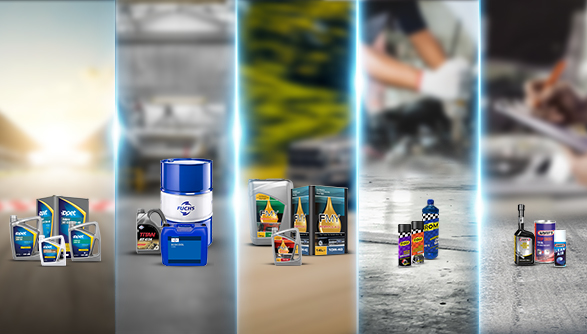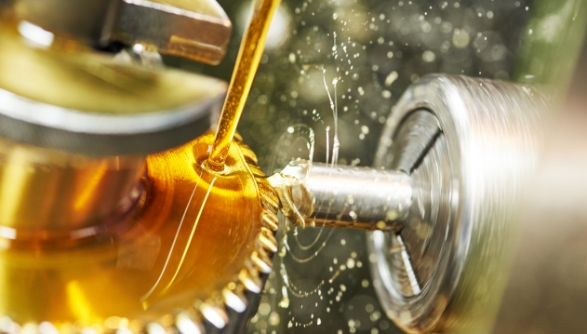FAQ About Lubricants

What are the Types of Coolants (Emulsions)?
They are categorized into 3 depending on their lubricant ratio: Mineral-Based Coolants, Semi-Synthetic Coolants & Fully-Synthetic Coolants. Mineral-Based Coolants: The lubricant ratio exceeds 40%. When mixed with water, they form emulsions in a milky appearance. Semi-Synthetic Coolants: The lubricant ratio is below 40%. When mixed with water, they form emulsions in a translucent appearance. Fully-Synthetic Coolants: They do not contain lubricant. When mixed with water, they form emulsions in a transparent appearance.
Does Oil Change Kilometer Vary According to the Type of Engine Oil?
In many respects, synthetic oils have superior properties than mineral oils. Long life is one of them. Compared to mineral oils, synthetic oils as a general principle it can be said to have the better extended oil drain intervals. However, the oil change intervals are determined by the vehicle manufacturers (OEMs) after a series of tests. Compliance with these oil change intervals is the best in terms of equipment health.
How Are Anti-Freeze Measurements Made?
The most appropriate method to accurately measure the freezing point of antifreeze is the use of a refractometer. How to use refractometer:Take the refractometer by holding it from the body with the side of the oblique prism where the sample is dripped from the body and holding the cover in the closed position and place the binocular section in the eye and try to read the value in the measurement table according to the refrigerant structure you use. If the values you see are not clear, you can rotate the measuring table immediately by turning the adjustment ring on the binoculars and adjust the sharpness. The value corresponding to the cross-section in the light-dark two phase in the table will give you the degree of protection. Since measurements with bomometer-like measuring devices give very variable results, it is not recommended to use antifreeze in freezing point measurement.
How Can Waste Engine Oils be Recycled?
PETDER serves free of charge regardless of quantity and distance throughout Turkey with its waste engine oil collecting organization. Waste producers may contact PETDER as the Authorized Establishment through the website www.petder.org.tr, via e-mail atikyag@petder.org.tr or via telephone 0212-229 39 99 to gain information or to have waste oil they collected in accordance with principals of regulation collected. The collecting process is monitored on satellite with central planning and is conducted by vehicles appropriate to EU standards and trained staff.
How Can We Choose the Proper Coolant?
The processed material and operation and working conditions are considered for selecting the coolant and they are formulated in different properties to obtain the desired performances. Its areas of application are extensive. Sometimes lubrication is at the forefront and at other times, the refrigerating feature or chip removal feature will be the key.
How is it Possible To Tell if Motor Oil Has Perished?
To understand for certain whether motor oil has perished, the oil should be analyzed physically and chemically under laboratory conditions.
In Case of Oil Loss, is it Possible to Add Oil to Another Brand?
As a general principle, mixing of oils with different properties and different brands is not appropriate. However, the decrease in oil was a variety of reasons and if it is necessary to complete the same viscosity and quality class can be added with other brand oils. It is recommended that the oil is completely drained and replaced with new oil at the most convenient time after the addition with another brand of oil. Hydraulic brake fluid at the same quality level can be mixed with each other regardless of brand.
What are the Causes of Corrosion?
The main causes of corrosion are exposure of the component to high temperature or open air, use of improper water, operation in low concentrations and low pH value.
What are the Conditions to Keep Grease?
Greases may leak during storage and base oil also tends to oscillate. The oil leakage rate will increase over time and will vary depending on the storage temperature. The grease should ideally be stored in a cool, dry interior and the ambient temperature should not exceed 30 °C and should not be less than 0 °C. The grease must be protected from dust, dirt, moisture or rainwater, and from direct sunlight.
What are the Considerations for Using Emulsion?
First, add water and then oil to form an emulsion. The ideal hardness value of water to be used for forming an emulsion should be 5-10 dH0 and the chloride level should be below 60 ppm. For effective coolant monitoring, measure daily the concentration, pH and conductivity values and keep them within the range of operating limits. Avoid contact of additives such as anti-bacteria/antifoam added to emulsions with skin and use proper protective equipment. The amount of foreign oil in an emulsion should not exceed 2%. Remove foreign oils accumulated on bench surfaces using oil scrapers. Regularly remove chips accumulated in bench emulsion tanks. Benches must be circulated 2-3 times a day to prevent the deterioration of emulsions in case of long downtime in the enterprises.
What are the Intended Uses of Grease?
With manual hand pump or air pump can be printed directly into the bearing. In systems with central automatic lubrication, the grease is filled into the central chamber, the pneumatic system greases the greasing points automatically with the specified intervals.
What Does 0W Mean?
0W, expresses the viscosity grade of the engine oil. 'W' comes from the word 'winter'. '0' shows the cold working conditions of the engine oil. The kinematic viscosity of a 0W engine oil at 100 °C is at least 3.8 cST, which is pumpable even at -40 °C.
What Does GL - 5 On Gear Oil Packages Mean?
It is the API classification used for gear oils. Oil that contains additives to balance excessive pressure and pulsed load for hypoid gear type differentials running under heavy conditions and that fulfills MIL-L-2105 specifications. In GL-5, there are more overpressure additives and it is generally used under heavy work conditions. Unless otherwise specified, GL-5 should not be used in places where GL-4 is recommended. Because the sulphide in overpressure additive which is present excessively in GL-5 corrodes yellow metals.
What Does It Mean If Oil Used In An Engine Turns Black?
One of the duties of engine oil is to keep systems clean. A qualified engine oil incorporates soot particles in engine after separating them and prevent them from sticking on metal surfaces due to the detergent-dispersant additives in its content. It cleans soot particles adherent on metal surfaces with cleaning agent. Therefore, engine oil becomes dirty and its color turns black. If the motor oil is dirty, it is doing its job well.
What Issues Should Be Considered When Changing Engine Oil?
Vehicle should be in 'stop' position and on a flat surface. The engine oil must be drained when hot. Ensure that the old oil in the engine crankcase fully discharged, whether used oil in engine pan is empty and whether pan bung is mounted properly.
What is Automotive Gear Lubricant SAE Viscosity Classification?
The Association of Automotive Engineers (SAE) classifies automotive gear oils according to their kinematic viscosity values at 100 °C and their pumpability at low temperatures. For example, the SAE 80W-90 in an automotive gear oil '90' describes the kinematic viscosity of this gear oil at 100 °C. As this number increases oil thickens, if the number decreases oil thins. The kinematic viscosity of '90' gear oil at 100 °C is between 13.50 and 18.50 cST while the kinematic viscosity of '140' gear oil at 100 °C must be between 24.00 and 32.50 cST. The number to the left of W (Winter) determines the performance of gear oil at low temperatures. Pumping temperature of '80W' gear oil is -26 °C while pumping temperature of '75W' gear oil is -40 °C.
What is Coolant (Emulsion)?
Fluids that are capable of emulsifying after mixing with water for use in metalworking operations (turning, milling, drilling, etc.). First, add water and then oil to form an emulsion. For additions, avoid adding water or oil alone.
What is Corrosion?
Corrosion is the abrasion of metal or metal alloys due to oxidation and other chemical effects and the damage caused by this reaction. As a result of this effect, metals may lose their metallic properties and the machine or component where the work is performed may become unusable.
What is Emulsion Concentration?
It is the amount of oil in the unit volume of the emulsion. It is expressed in % (oil volume/total emulsion volume x 100).
What is Oil Performance and How Can We Observe it?
The information on the oil packaging contains important clues about performance of the oil. There should be information about five issues on the packaging in general. These; brand, its contents (be mineral, synthetic or synthetic based), viscosity grade (such as 5W-30, 10W-40), international performances (such as API CK-4, ACEA C3), OEM performances (such as MB-Approval 228.51, Volvo VDS- 4, VW 504 00/507 00).
What is the Aim of Lubrication?
The aim of lubrication is to decrease friction by separating two surfaces, to ease movement by lubricating surfaces, to make cooling, to minimize wear and to avoid corrosion by generating film on the surface.
What is the Difference Between Synthetic Oil and Mineral Oil?
Synthetic based oils are oils produced with chemical methods. They are produced to lubricate in applications where traditionally obtained mineral oils cannot be sufficient. Synthetic-based oils provide superior protection at higher temperatures than minerals, easier flow and pumpability at low temperatures , more stable film strength under extreme pressure and longer drain interval in difficult operating conditions.
What Springs to Mind When it Comes to Viscosity?
Viscosity is the resistance of fluids against flowing. An oil film is formed between the two surfaces under pressure with viscosity and system parts are provided to work for long years without abrasion.
What Water Properties are Required for Use in Emulsions?
The ideal hardness value of water to be used to form an emulsion should be 5-10 dH0 and the chloride level should be below 60 ppm.
Where is Grease Used?
In terms of application of lubricating with oil where it is not possible to use grease especially in ball bearings.
Why are Synthetic Oils More Expensive?
Synthetic oils are produced through very complex processes with advanced technology, it costs higher than mineral oils. That influences the price of the product.
Why Concentration is Crucial in Emulsions?
Emulsions have ideal use concentrations and these values are set depending on the products and operations used. Emulsion performance depends on operating in the ideal concentration range specifically determined for each product.
Why Does Bacteria Form in Emulsions?
Any external oil accumulated on the emulsion causes the emulsion to become anaerobic, thus preventing the exchange of oxygen. The anaerobic emulsion creates an ideal environment for bacteria reproduction. In an ideal environment, one million bacteria can reproduce from a single bacterium within 15 hours. This division does not always continue at the same pace. Constant low concentration results in bacterial reproduction in the emulsion.
Why Should Antifreeze be Used in Four Seasons?
Antifreeze protects the cylinder block / barrel, circulation pump, hoses, gaskets and the padding from corrosion. Therefore it should be used in 4 seasons. ➢It shows resistance against freezing in winter while shows resistance against overheating in summer. ➢Antifreeze must be mixed with pure water. 50/50 mixture of water and antifreeze is the most suitable mixture. In this way the freezing point can be lowered to -38 °C.
 TR
TR





